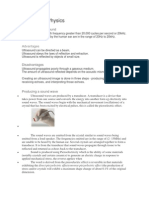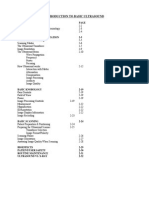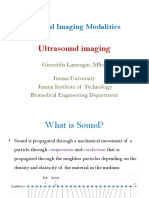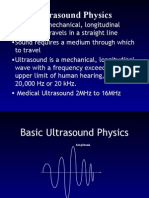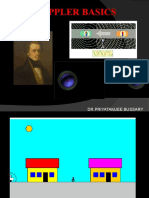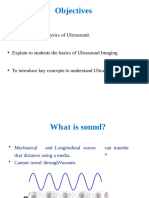Ostate Testicles
Uploaded by
greathari1998Ostate Testicles
Uploaded by
greathari1998ostate, or their testicles (for
example to
distinguish epididymitis fromtesticu
lar torsion). In young males, it is
used to distinguish more benign
testicular masses
(varicocele or hydrocele)
from testicular cancer, which is
highly curable but which must be
treated to preserve health and
fertility. There are two methods of
performing a pelvic sonography
externally or internally. The internal
pelvic sonogram is performed
either transvaginally(in a woman)
or transrectally (in a man).
Sonographic imaging of the pelvic
floor can produce important
diagnostic information regarding
the precise relationship of
abnormal structures with other
pelvic organs and it represents a
useful hint to treat patients with
symptoms related to pelvic
prolapse, double incontinence and
obstructed defecation. It is used to
diagnose and, at higher
frequencies, to treat (break up)
kidney stones or kidney crystals
(nephrolithiasis).
[5]
Musculoskeletal
tendons, muscles, nerves,
ligaments, soft tissue masses,
and bone surfaces
[6]
Cardiovascular system
To assess patency and possible
obstruction of arteries Arterial
sonography, diagnose deep
vein
thrombosis (Thrombosonograph
y) and determine extent and
severity of venous insufficiency
(venosonography)
Intravascula
r ultrasound
Other types of uses include:
Interventional ultrasonography; biopsy, emptying fluids,
intrauterine transfusion
[disambiguation needed]
(Hemolytic disease of the newborn)
Contrast-enhanced ultrasound
A general-purpose sonographic machine may be used for most imaging
purposes. Usually specialty applications may be served only by use of a specialty
transducer. Most ultrasound procedures are done using a transducer on the
surface of the body, but improved diagnostic confidence is often possible if a
transducer can be placed inside the body. For this purpose, specialty
transducers, including endovaginal, endorectal, and transesophageal
transducers are commonly employed. At the extreme of this, very small
transducers can be mounted on small diameter catheters and placed into blood
vessels to image the walls and disease of those vessels.
A sonogram (not to be confused with an ultrasound scan) uses the reflections of
high-frequency sound waves to construct an image of a body organ.
From sound to image[edit]
The creation of an image from sound is done in three steps producing a sound
wave, receiving echoes, and interpreting those echoes.
Producing a sound wave[edit]
Medical sonographic instrument
A sound wave is typically produced by a piezoelectric transducer or a capacitive
micromachined transducer, encased in a housing which can take a number of
forms. Strong, short electrical pulses from the ultrasound machine make the
transducer ring at the desired frequency. The frequencies can be anywhere
between 2 and 18 MHz. The sound is focused either by the shape of the
transducer, a lens in front of the transducer, or a complex set of control pulses
from the ultrasound scanner machine (Beamforming). This focusing produces an
arc-shaped sound wave from the face of the transducer. The wave travels into
the body and comes into focus at a desired depth.
Older technology transducers focus their beam with physical lenses. Newer
technology transducers use phased array techniques to enable the sonographic
machine to change the direction and depth of focus. Almost all piezoelectric
transducers are made of ceramic.
Materials on the face of the transducer enable the sound to be transmitted
efficiently into the body (usually seeming to be a rubbery coating, a form
of impedance matching). In addition, a water-based gel is placed between the
patient's skin and the probe.
The sound wave is partially reflected from the layers between different tissues.
Specifically, sound is reflected anywhere there are density changes in the body:
e.g. blood cells in blood plasma, small structures in organs, etc. Some of the
reflections return to the transducer.
Receiving the echoes[edit]
The return of the sound wave to the transducer results in the same process that it
took to send the sound wave, except in reverse. The return sound wave vibrates
the transducer, the transducer turns the vibrations into electrical pulses that
travel to the ultrasonic scanner where they are processed and transformed into a
digital image.
Forming the image[edit]
The sonographic scanner must determine three things from each received echo:
1. How long it took the echo to be received from when the sound was
transmitted.
2. From this the focal length for the phased array is deduced, enabling a
sharp image of that echo at that depth (this is not possible while producing
a sound wave).
3. How strong the echo was. It could be noted that sound wave is not a click,
but a pulse with a specific carrier frequency. Moving objects change this
frequency on reflection, so that it is only a matter of electronics to have
simultaneous Doppler sonography.
Once the ultrasonic scanner determines these three things, it can locate which
pixel in the image to light up and to what intensity and at what hue if frequency is
processed (see redshift for a natural mapping to hue).
Transforming the received signal into a digital image may be explained by using
a blank spreadsheet as an analogy. First picture a long, flat transducer at the top
of the sheet. Send pulses down the 'columns' of the spreadsheet (A, B, C, etc.).
Listen at each column for any return echoes. When an echo is heard, note how
long it took for the echo to return. The longer the wait, the deeper the row (1,2,3,
etc.). The strength of the echo determines the brightness setting for that cell
(white for a strong echo, black for a weak echo, and varying shades of grey for
everything in between.) When all the echoes are recorded on the sheet, we have
a greyscale image.
Displaying the image[edit]
Images from the sonographic scanner can be displayed, captured, and broadcast
through a computer using a frame grabberto capture and digitize the analog
video signal. The captured signal can then be post-processed on the computer
itself.
[7]
For computational details see also: Confocal laser scanning microscopy, Radar,
Sound in the body[edit]
Linear array transducer
Ultrasonography (sonography) uses a probe containing multiple
acoustictransducers to send pulses of sound into a material. Whenever a sound
wave encounters a material with a different density (acoustical impedance), part
of the sound wave is reflected back to the probe and is detected as an echo. The
time it takes for the echo to travel back to the probe is measured and used to
calculate the depth of the tissue interface causing the echo. The greater the
difference between acoustic impedances, the larger the echo is. If the pulse hits
gases or solids, the density difference is so great that most of the acoustic
energy is reflected and it becomes impossible to see deeper.
The frequencies used for medical imaging are generally in the range of 1 to
18 MHz. Higher frequencies have a correspondingly smaller wavelength, and can
be used to make sonograms with smaller details. However, the attenuation of the
sound wave is increased at higher frequencies, so in order to have better
penetration of deeper tissues, a lower frequency (35 MHz) is used.
Seeing deep into the body with sonography is very difficult. Some acoustic
energy is lost every time an echo is formed, but most of it
(approximately ) is lost from acoustic absorption. (See
also Acoustic attenuation for further details on modeling of acoustic attenuation
and absorption.)
The speed of sound varies as it travels through different materials, and is
dependent on the acoustical impedance of the material. However, the
sonographic instrument assumes that the acoustic velocity is constant at
1540 m/s. An effect of this assumption is that in a real body with non-uniform
tissues, the beam becomes somewhat de-focused and image resolution is
reduced.
To generate a 2D-image, the ultrasonic beam is swept. A transducer may be
swept mechanically by rotating or swinging. Or a 1D phased array transducer
may be used to sweep the beam electronically. The received data is processed
and used to construct the image. The image is then a 2D representation of the
slice into the body.
3D images can be generated by acquiring a series of adjacent 2D images.
Commonly a specialised probe that mechanically scans a conventional 2D-image
transducer is used. However, since the mechanical scanning is slow, it is difficult
to make 3D images of moving tissues. Recently, 2D phased array transducers
that can sweep the beam in 3D have been developed. These can image faster
and can even be used to make live 3D images of a beating heart.
Doppler ultrasonography is used to study blood flow and muscle motion. The
different detected speeds are represented in color for ease of interpretation, for
example leaky heart valves: the leak shows up as a flash of unique color. Colors
may alternatively be used to represent the amplitudes of the received echoes
You might also like
- Cot DLP Science 6-Simple Machines With Annotations100% (21)Cot DLP Science 6-Simple Machines With Annotations9 pages
- Introduction To The Physical Principles of Ultrasound Imaging and Doppler Peter N Burns PHDNo ratings yetIntroduction To The Physical Principles of Ultrasound Imaging and Doppler Peter N Burns PHD26 pages
- Ultrasonography Machine: SR - No Topic Name Page NoNo ratings yetUltrasonography Machine: SR - No Topic Name Page No30 pages
- PHY370 - Chapter 3.0 - Wave Motion and Sound PDFNo ratings yetPHY370 - Chapter 3.0 - Wave Motion and Sound PDF47 pages
- 1.1 Research Background 1.1.1 Traditional Ultrasound ImagingNo ratings yet1.1 Research Background 1.1.1 Traditional Ultrasound Imaging12 pages
- Point-Of-Care Ultrasonography For ObstetricsNo ratings yetPoint-Of-Care Ultrasonography For Obstetrics22 pages
- Ultrasound physics ........... Dr Mazhar 03066980980(1)No ratings yetUltrasound physics ........... Dr Mazhar 03066980980(1)30 pages
- Introduction To Ultrasound in Emergency Department: A&E Medical MeetingNo ratings yetIntroduction To Ultrasound in Emergency Department: A&E Medical Meeting24 pages
- The Essential Physics of Medical Imaging - Cap 14No ratings yetThe Essential Physics of Medical Imaging - Cap 1477 pages
- Lectures On Medical Biophysics: Dept. Biophysics, Medical Faculty, Masaryk University in Brno100% (1)Lectures On Medical Biophysics: Dept. Biophysics, Medical Faculty, Masaryk University in Brno69 pages
- Doppler Basics: DR - Priyatamjee BussaryNo ratings yetDoppler Basics: DR - Priyatamjee Bussary79 pages
- Ultrasonic Terminology Ultrasonic Terminology: Dr. Hella J. Al - FatlawyNo ratings yetUltrasonic Terminology Ultrasonic Terminology: Dr. Hella J. Al - Fatlawy45 pages
- Principle and Application of UltrasonographyNo ratings yetPrinciple and Application of Ultrasonography6 pages
- Basic Principles of Ultrasound.: Dr/Abd Allah Nazeer. MDNo ratings yetBasic Principles of Ultrasound.: Dr/Abd Allah Nazeer. MD50 pages
- Towards A Robust Face Recognition System Using Compressive SensingNo ratings yetTowards A Robust Face Recognition System Using Compressive Sensing4 pages
- Spe/Ladc: Spe/Ladc 18700 Underreamer Improvements For Drilling Moving Salt FormationsNo ratings yetSpe/Ladc: Spe/Ladc 18700 Underreamer Improvements For Drilling Moving Salt Formations10 pages
- Education Experience: Cleo Cassandra KayeNo ratings yetEducation Experience: Cleo Cassandra Kaye1 page
- Regional Economic Development Hui - NapierNo ratings yetRegional Economic Development Hui - Napier35 pages
- Simulink Exercises For - Digital Communications - A Discrete-Time Approach, - by MNo ratings yetSimulink Exercises For - Digital Communications - A Discrete-Time Approach, - by M2 pages
- Linkedin Contact: 713.784.3870: Joe McdonaldNo ratings yetLinkedin Contact: 713.784.3870: Joe Mcdonald5 pages
- Depliant-Refrigerators - EVERmed LD 625WNo ratings yetDepliant-Refrigerators - EVERmed LD 625W12 pages
- Can Bangladesh Benefit From GlobalisationNo ratings yetCan Bangladesh Benefit From Globalisation3 pages
- Catalog 79027ENG HOKE 7C Series Valve English 101414No ratings yetCatalog 79027ENG HOKE 7C Series Valve English 10141412 pages
- MS-26 Vii: Asphalt - FM - Indd 7 7/9/11 2:57 PMNo ratings yetMS-26 Vii: Asphalt - FM - Indd 7 7/9/11 2:57 PM5 pages
